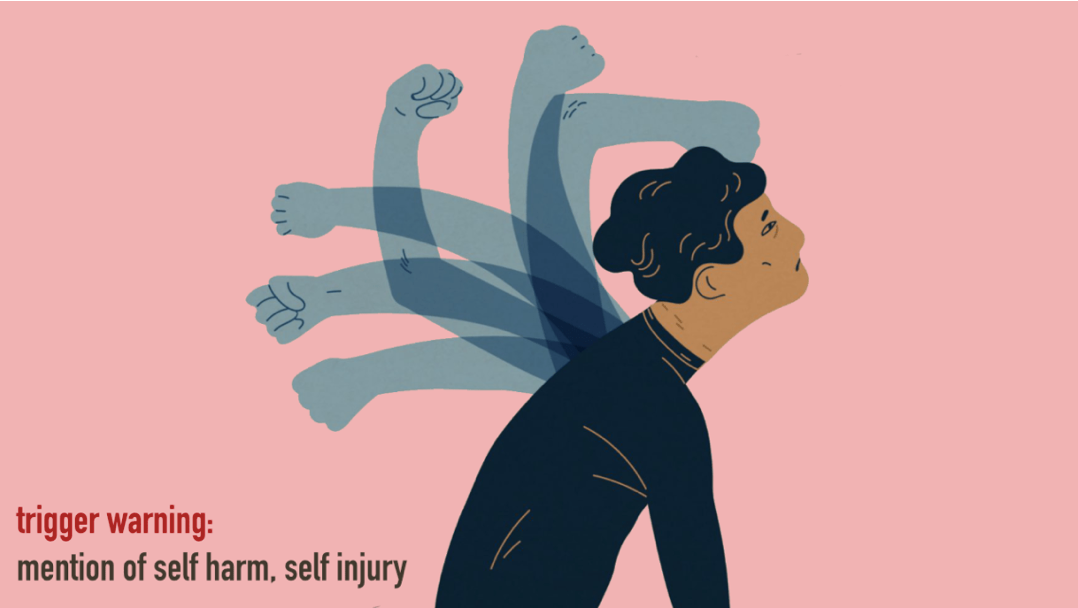TRIGGER WARNING: this post includes information about self-harm and self injury that may be triggering and distressing.
Self-harm means that you harm yourself on purpose. While it is not a mental health problem in itself, it is often linked to acute mental distress. The need to hurt or harm one’s own body stems from frustration, stress, and situations in life that are out of our control. This stress can be physical, psychological or emotional. Self-harm is therefore used as a way of dealing with stressors and frustration when it becomes too overwhelming.
Even though it may seem like a good idea at the time, self-harm can be incredibly dangerous in the long run. It can have unintended consequences on an individual’s health and appearance and might also cause serious injuries, hospitalisation or death.
Trust us when we say this: even though we end up hiding our feelings and emotions, it isn’t fun trying to hide the scars, the cuts or the bruises – in fact it can get even more stressful!
We understand that it feels as though there’s no light at the end of your tunnel and you feel there’s no other way to deal with what you’re feeling, but we promise that there are better ways to cope with different stressors in our lives and things will not always remain like this.
Try seeking professional help or reach out to us and we will try our best to guide and help you out with your mental health concerns.
Also remember that you are responsible for your own health and it is important that your actions do not cause immense distress, harm or damage to yourself as well as to other people or things around you.
We accept no liability for unfavourable outcomes as a result of this advice. If in doubt, we advise you speak to your General Practitioner, a medical professional or a trusted adult.
Safer Self-Harm:
Experts have put together a list of safer ways to self-harm, many of which are proven to give the same release and effect as other means, but with much less risk. Instead of putting yourself at risk physically, try doing these activities instead:
If you’re frustrated and angry:
-
Slap a hard surface – such as a wall or tabletop
-
Punch a cushion or punching bag or maybe even consider learning martial arts
-
Flatten aluminum cans for recycling – see how fast you can do it
-
Find somewhere isolated and scream as loudly as you possibly can (alternatively do it into a cushion)
-
Take part in high-intensity exercise; like circuit training, boxing, running or swimming
If you’re stressed and the emotions overpower you:
-
Take a cold bath
-
Play music really loudly
-
Try squeezing a stress ball
-
Find a lake or ocean and throw stones into the water as hard and as far as you can
-
Write down exactly how you are feeling in a diary – or if you’d prefer to, or just scribble everything out till the stress is out of your system!
-
Reach out – Talk to someone you trust (or talk to yourself in the mirror like you are talking to your best friend)
-
Give yourself a hair makeover, you would still be making drastic changes, but you can always grow your hair back
-
Look after and be kind to yourself; it doesn’t have to be something active. (You could try aromatherapy oil!)
If the thoughts related to self-harm are overwhelming:
-
Use a red marker pen to draw or write words (or put stickers) on the place where you want to cut
-
Paint on your body instead
-
Squeeze ice in your hands really hard
-
Squeeze the ‘pores’ in the skin of an orange / satsuma / clementine (take care to avoid getting juice in your eyes)
-
Find an old magazine or newspaper and tear it up
-
Snap a rubber band against your wrist
Self-harm is not the answer to your problems but doing the above things as a short-term measure could be safer ways of releasing the emotion and stress you felt in the moment.
While there are ways to curb hurting yourself physically, if one does go ahead with self-harming, it is always risky. You might want to lower the physical damage you do when you self-harm by following some guidelines for the least damage caused. This is called harm reduction.
Reduce the harm
-
Clean the things you are using to harm yourself first. Put them in boiling water or using a sterilising fluid can reduce the risk of infection. There is a decreased risk to infection if the tool you are using is sterilised.
-
Do not share self-harming tools with other people. There is a risk you could get a disease (including hepatitis B, hepatitis C, HIV and AIDS).
-
Remember sharp implements become blunter over time so they might not work in the same way as before. Replace them regularly and test the pressure you use on something else before yourself – orange peel is useful for this.
-
Try using candle wax instead of lighter, hot metal, or match sticks.
-
Don’t self-harm in areas where you have lots of scars. Scar tissue may not be as strong as your skin.
-
Avoid drugs or alcohol. They can affect your judgement
-
Be aware that over-the-counter drugs are dangerous too, even a small overdose can have serious side effects, especially with paracetamol.
Take care of yourself
Reach out immediately:
Usually, the need and thoughts of self-harm peaks when you feel distress, anxiety or loss of control in your surroundings and lasts for an hour. After which, the urge for the same might reduce. Another way of dealing with these thoughts is to distract oneself from the thoughts in the first place. We understand that sometimes these thoughts are overpowering and they guide our behaviour – but dealing with these might be easier than you believe.
If you want to reduce the self-harming behaviour, try to increase the time passing between the thoughts that lead to it and acting on it. Distract yourself, or sit with your thoughts but let time pass by and avoid the impulse of acting on your thoughts at the first go.
-
Change of environment:
Use this energy somewhere else. The sudden surge may die down if you change the environment completely. Go for a walk, get out of the physical space itself. If not, call someone you like talking to and have a conversation with them.
-
Put the energy somewhere else:
You like baking, drawing, painting, writing, creating art? Take all the energy you have and bake, clean, cook or create instead! (Remember that it doesn’t have to be the yummiest of dishes or prettiest of art, just make sure you do what you like for an hour or two.)
-
Practice mindfulness:
Your negative thoughts are overpowering everything else in that moment, right? Try to be mindful of the things around you at that time. Pick an object (absolutely anything!), close your eyes and feel all the different textures, layers, and shapes of the object – then write a descriptive piece on it. If you are having bad thoughts about yourself or feeling guilty, write down everything good about yourself, or everything you’re grateful for – and continue till you feel better!
It might be a good idea to reach out mental health professionals, friends or family if you have had or acted on thoughts of self-harm for safety. Please reach out to us and we will make sure to guide you and help you out with your emotional and mental health concerns.

